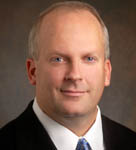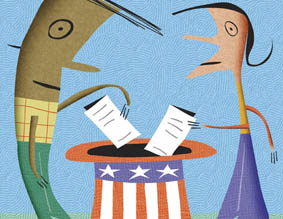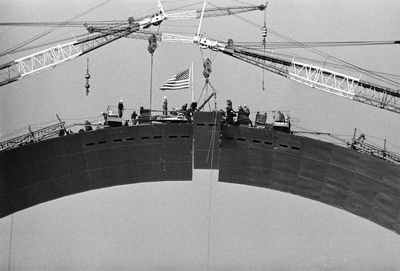It was in the UK College of Arts & Science that Tracy Campbell learned to think like a historian, and to see the connective tissues of historical events.
“To me UK is a magical place,” Campbell said. “I was a changed person by the time I graduated. Those required classes that A&S made me take kicking and screaming opened up whole new worlds for me.”
 Today, Campbell is infusing the next generation of UK students with the curiosity, technique and enthusiasm of a historian as a professor in the UK Department of History. His effectiveness in the classroom was recently recognized with a 2010 Great Teacher Award given by the UK Alumni Association. This honor is the oldest continuous award recognizing excellence in teaching at UK, and nominations are made exclusively by the student body.
Today, Campbell is infusing the next generation of UK students with the curiosity, technique and enthusiasm of a historian as a professor in the UK Department of History. His effectiveness in the classroom was recently recognized with a 2010 Great Teacher Award given by the UK Alumni Association. This honor is the oldest continuous award recognizing excellence in teaching at UK, and nominations are made exclusively by the student body.
Campbell’s excellence in teaching is mirrored by his excellence in research. “To me, teaching and research go hand in hand. They absolutely inform one another. The insights and the questions I bring to my research necessarily make me a better teacher. But also I come out of class all the time thinking, ‘Gee, when I presented it this way, it really worked. I need to go back and write that chapter differently.’”
A prolific writer and researcher, Campbell is currently working on a book about the St. Louis Gateway Arch for the Yale University Press Icons of America series. The journey that led him to write this book is like one of those stories that start with a butterfly flapping its wings in the rainforest.
While deep in the dusty stacks of the King Library researching his dissertation written at Duke University, Campbell ran across the 250 page senior thesis that Kentuckian Edward F. Prichard, Jr. wrote while at Princeton. That ultimately led to Campbell’s biography of the Bourbon County native, U.S. Supreme Court clerk and would-be political star whose reputation was forever damned when he was convicted of stuffing ballot boxes to win the Kentucky gubernatorial election in 1948.
 “Prichard said he was part of a larger culture that considered elections a game. So I thought more about that culture and that led to Deliver the Vote,” said Campbell, explaining the germ of his 2005 book "Deliver the Vote: A History of Election Fraud, an American Political Tradition-1742-2004."
“Prichard said he was part of a larger culture that considered elections a game. So I thought more about that culture and that led to Deliver the Vote,” said Campbell, explaining the germ of his 2005 book "Deliver the Vote: A History of Election Fraud, an American Political Tradition-1742-2004."
Research for Deliver the Vote took Campbell all over the country investigating incidents of alleged voting fraud. One such trip took him to St. Louis, Mo., where Campbell spent days straining over newspaper microfiche researching a 1935 St. Louis referendum vote for something called the Jefferson National Expansion Memorial Project.
Today, this memorial is known as the St. Louis Gateway Arch.
“It’s unlike anything in the United States,” Campbell said. “Every other memorial has a specific meaning. People go to the Statue of Liberty or the Vietnam Wall for a specific political or emotional reason. Yet why do 3.5 million people a year visit the Gateway Arch?”
“We just don’t build 630-foot tall abstract works of art in this country. Except this one time.”
The Gateway Arch has come to symbolize a number of things: Thomas Jefferson and the Louisiana Purchase, westward expansion, the pioneer spirit, Lewis & Clark. The Arch’s shifting purpose makes more sense to Campbell now that he understands its origins. “It’s morphed into a lot of other symbols because it was never meant to be a memorial, it was meant to be a real estate deal to clear 37 blocks of land.”
Campbell’s book, coming out in 2011, will outline the whole story of the Gateway Arch from the city stuffing the ballot boxes in 1935 to the civil rights demonstrations in the 1960s surrounding the “whites only” building of the Arch, which is ironic given that the Arch was originally sold as a jobs program for the thousands of African Americans in St. Louis suffering from the Depression.
 Yet despite its shady origins, it can’t be denied that the Arch is both an exquisite architectural accomplishment as well as a representation of the complexities of the American spirit.
Yet despite its shady origins, it can’t be denied that the Arch is both an exquisite architectural accomplishment as well as a representation of the complexities of the American spirit.
“This cannot be a book just about seedy politicians,” said Campbell, reflecting on his work in progress. “Because as monumental art, it’s breathtaking. Who knows what institutions or structures will survive 1,000 years from now, but future generations will probably be looking at the Arch as we look at the pyramids today. The monuments we build tell us a lot about what a society wants to remember. I am interested in the ways that memory is constructed, literally, as well as politically and culturally. ”
